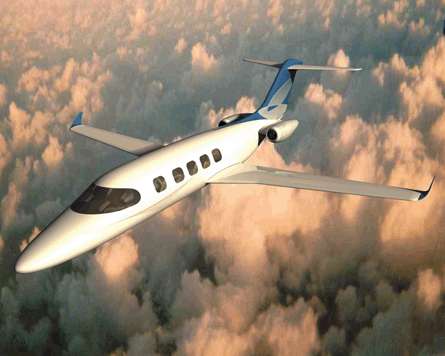Despite the current economic gloom, business aviation start-ups are striving to bring their products to market and avoid becoming yet another failing statistic in this highly volatile and cash intensive industry that has become the resting place of so many failed programmes.
Honda Aircraft plans to start a four-aircraft flight-test and certification programme for its new light jet in the third quarter and says it is in the process of hiring 100 engineers with experience in new aircraft design, development and certification and will grow its head count to 400 this year.
Honda is developing a new $100 million facility at Greensboro's Piedmont Triad International airport, North Carolina. The first phase of this facility housing the company's sales, marketing and administration staff, opened a year ago and an 18,600m² (200,000ft²) research and development building was completed in December 2008.
The third and final phase of the project, featuring a production facility, will open in 2010. Honda is preparing for the start of manufacturing later the same year to coincide with the certification and delivery of the first HondaJet. Honda says it aims to eventually ramp up to a production rate of 80-100 aircraft a year, which is needed for it to achieve the production efficiencies employed at Honda's automotive division.
 |
|---|
© Spectrum |
The company claims sales of the GE Honda HF120-powered HondaJet have remained robust despite the economic downturn, but will not disclose how many orders it has secured. The HondaJet will be able to cruise at up to 420kt (780km/h) and offers a six-seat cabin with a lavatory. Honda claims the HondaJet has the cabin and performance of a light jet, but at a purchase price and fuel efficiency of a very light jet, says Honda.
Spectrum Aeronautical is aiming at late-2010 certification of its HF120-powered midsize S-40 Freedom - more than a year behind its original schedule due to the 2005 fatal crash of the first prototype. "We are about a year away from flying the first prototype and we are building the production tooling," says Spectrum president Austin Blue.
He says the company has been prudent with the funding it has raised to date for the S-40 development programme. "We have enough investment to keep us going. Our strength is that we haven't built up large overheads and infrastructure but have focused on developing the advanced composites [through its Rocky Mountain Composites subsidiary] for our aircraft as well as other industries."
Blue says Spanish Fork, Utah-based Spectrum has not ruled out forming a joint venture partnership with existing airframers to bring the aircraft to market. "OEMs will bring the infrastructure as we will bring the technology," he says.
The $6.8 million S-40 is powered by GE Honda HF120 turbofan engines. The Freedom is designed to have a 1.8m (5.9ft) stand-up-cabin and a maximum speed of 440kt, a range of 4,170km (2,250nm) and maximum cruising altitude of 45,000ft. Approval of the $3.95 million, Williams FJ-33-powered S-33 Independence very light jet stablemate is earmarked around 12 months later.
"The orderbook for both aircraft has been open for a couple of years and we are pleased with the numbers we have received, which takes us well beyond the first year of production," says Blue.
Source: Flight International























